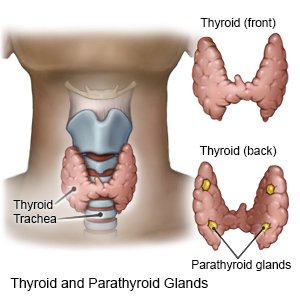Parathyroid Adenoma
Medically reviewed by Drugs.com. Last updated on Aug 4, 2025.
AMBULATORY CARE:
A parathyroid adenoma
is a benign (not cancerous) tumor on one or more of your parathyroid glands. The parathyroid glands are 4 small glands located near the thyroid gland in your neck. The parathyroid gland produces parathyroid hormone (PTH). PTH keeps the level of calcium balanced in your blood. A parathyroid adenoma can cause extra PTH to be produced. This condition is called hyperparathyroidism. Hyperparathyroidism can cause blood calcium levels to increase, and lead to health problems such as osteoporosis (weak, brittle bones). The cause of parathyroid adenomas is usually not known.
 |
Common signs and symptoms include the following:
You may not have any signs or symptoms. You may have symptoms of increased blood calcium if your parathyroid adenoma has caused hyperparathyroidism. You may have any of the following:
- Muscle weakness
- Fatigue
- Nausea, vomiting, or abdominal pain
- Constipation
- Depression or anxiety
- General body aches and pains
- Bone and joint pain
- Loss of appetite
- Confusion or forgetfulness
- Increased thirst and urination
Seek care immediately if:
- You heart beats faster or slower than normal, or it feels like fluttering in your chest.
- You have nausea, vomiting, and abdominal pain.
- You cannot think clearly.
Related medications
Contact your healthcare provider if:
- You have bone and joint pain.
- You have pain in your lower back, side, or stomach.
- You have pain or burning when you urinate or your urine is pink or red.
- You have increased thirst or you are urinating more often than usual.
- You have a loss of appetite.
- You have questions or concerns about your condition or care.
Treatment:
Surgery may be done to remove the adenoma or parathyroid gland.
Follow up with your doctor as directed:
Write down your questions so you remember to ask them during your visits.
© Copyright Merative 2025 Information is for End User's use only and may not be sold, redistributed or otherwise used for commercial purposes.
The above information is an educational aid only. It is not intended as medical advice for individual conditions or treatments. Talk to your doctor, nurse or pharmacist before following any medical regimen to see if it is safe and effective for you.
Further information
Always consult your healthcare provider to ensure the information displayed on this page applies to your personal circumstances.
